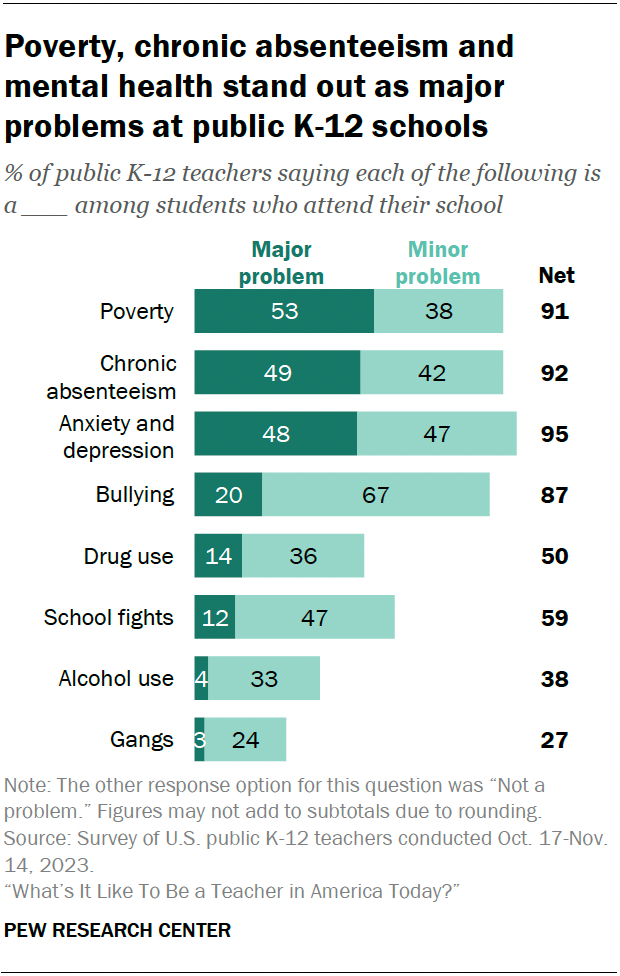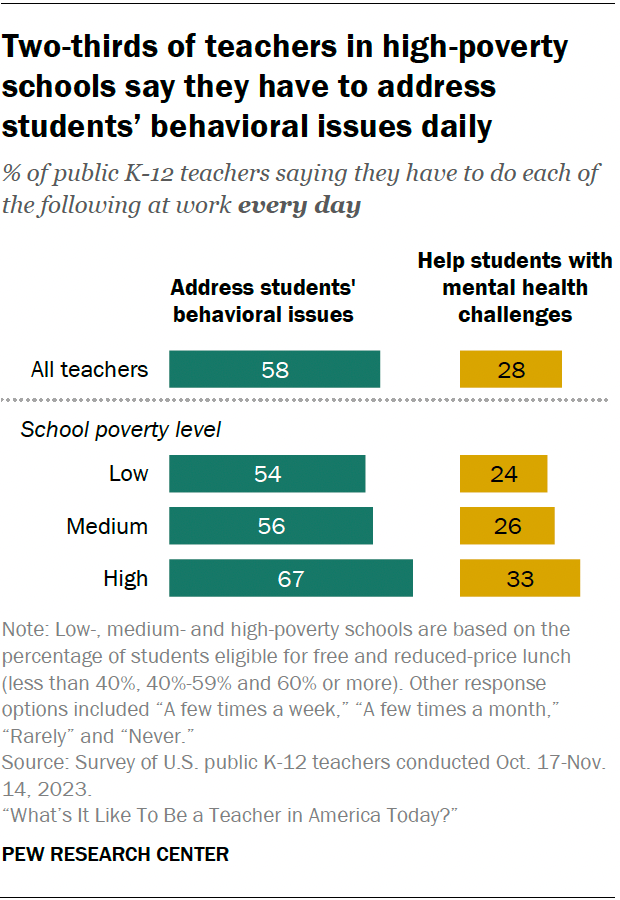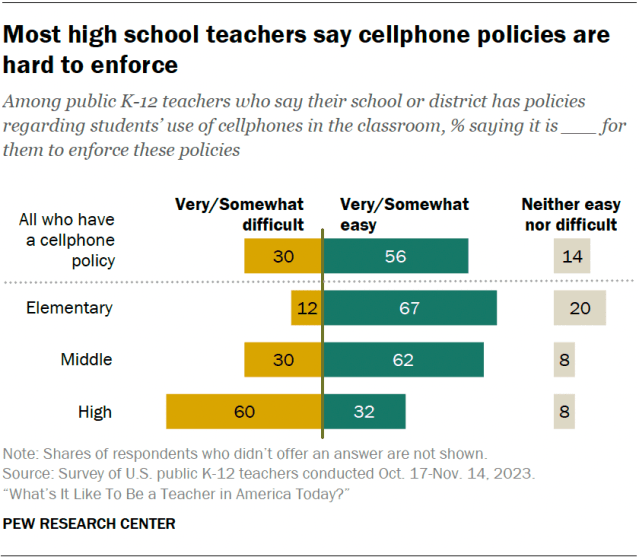Public K-12 schools in the United States face a host of challenges these days – from teacher shortages to the lingering effects of COVID-19 learning loss to political battles over curriculum.

In the midst of all this, teachers express low levels of satisfaction with their jobs. In fact, they’re much less satisfied than U.S. workers overall.
Here’s how public K-12 teachers are feeling about their jobs:
- 77% say their job is frequently stressful.
- 68% say it’s overwhelming.
- 70% say their school is understaffed.
- 52% say they would not advise a young person starting out today to become a teacher.
When it comes to how their students are doing in school, teachers are relatively downbeat about both academic performance and behavior.
Here’s how public K-12 teachers rate academic performance and behavior at their school:

- 48% say the academic performance of most students at their school is fair or poor. A third say it’s good, and only 17% describe it as excellent or very good.
- 49% say the behavior of most students at their school is fair or poor; 35% say it’s good and 13% say it’s excellent or very good.
The COVID-19 pandemic likely compounded these issues. About eight in ten teachers (among those who have been teaching for at least a year) say the lasting impact of the pandemic on students’ behavior, academic performance, and emotional well-being has been very or somewhat negative.
Assessments of student performance and behavior differ widely by school poverty level.1 Teachers in high-poverty schools have a much more negative outlook. However, feelings of stress and dissatisfaction among teachers are fairly universal, regardless of where they teach.

As they navigate these challenges, teachers don’t feel they’re getting the support or reinforcement they need from parents.
Majorities of teachers say parents are doing too little when it comes to holding their children accountable if they misbehave in school, helping them with their schoolwork, and ensuring their attendance.
Teachers in high- and medium-poverty schools are more likely than those in low-poverty schools to say parents are doing too little in each of these areas.
These findings are based on a survey of 2,531 U.S. public K-12 teachers conducted Oct. 17-Nov. 14, 2023, using the RAND American Teacher Panel.
Problems students are facing

We asked teachers about some of the challenges students at their school are facing. Three problems topped the list:
- Poverty (53% say this is a major problem among students who attend their school)
- Chronic absenteeism (49%)
- Anxiety and depression (48%)
Poverty cuts across the urban-rural divide, with roughly equal shares of teachers in urban schools (62%) and rural schools (60%) saying this is a major problem among their students. In suburban schools, a smaller share of teachers (42%) say the same.
Chronic absenteeism (that is, students missing a substantial number of school days) is a particular challenge at high schools, with 61% of high school teachers saying this is a major problem where they teach. By comparison, 46% of middle school teachers and 43% of elementary school teachers say the same.
Anxiety and depression are viewed as a more serious problem at the secondary school level: 69% of high school teachers and 57% of middle school teachers say this is a major problem among their students, compared with 29% of elementary school teachers.
Fewer teachers (20%) view bullying as a major problem at their school, though the share is significantly higher among middle school teachers (34%).
A look inside the classroom
We also asked teachers how things are going in their classroom and specifically about some of the issues that may get in the way of teaching.
- 47% of teachers say students showing little or no interest in learning is a major problem in their classroom. The share rises to 58% among high school teachers.
- 33% say students being distracted by their cell phones is a major problem. This is particularly an issue for high school teachers, with 72% saying this is a major problem.
- About one in five teachers say students getting up and walking around when they’re not supposed to and being disrespectful toward them (21% each) are major problems. Teachers in elementary and middle schools are more likely than those in high schools to see these as challenges.
A majority of teachers (68%) say they’ve experienced verbal abuse from a student – such as being yelled at or threatened. Some 21% say this happens at least a few times a month.
Physical violence is less common. Even so, 40% of teachers say a student has been violent toward them, with 9% saying this happens at least a few times a month.
About two-thirds of teachers (66%) say that the current discipline practices at their school are very or somewhat mild. Only 2% say the discipline practices at their school are very or somewhat harsh, while 31% say they are neither harsh nor mild. Most teachers (67%) say teachers themselves don’t have enough influence in determining discipline practices at their school.
Behavioral issues and mental health challenges

In addition to their teaching duties, a majority of teachers (58%) say they have to address behavioral issues in their classrooms every day. About three in ten teachers (28%) say they have to help students with mental health challenges daily.
In each of these areas, elementary and middle school teachers are more likely than those at the high school level to say they do these things daily.
And teachers in high-poverty schools are more likely than those in medium- and low-poverty schools to say they deal with these issues each day.
Cellphone policies and enforcement

Most teachers (82%) say their school or district has policies regarding cellphone use in the classroom.
Of those, 56% say these policies are at least somewhat easy to enforce, 30% say they’re difficult to enforce, and 14% say they’re neither easy nor difficult to enforce.
Experiences with cellphone policies vary widely across school levels. High school teachers (60%) are much more likely than middle school (30%) and elementary school teachers (12%) to say the policies are difficult to enforce (among those who say their school or district has a cellphone policy).
How teachers are experiencing their jobs
Thinking about the various aspects of their jobs, teachers are most satisfied with their relationship with other teachers at their school (71% are extremely or very satisfied).
They’re least satisfied with how much they’re paid – only 15% are extremely or very satisfied with their pay, while 51% are not too or not at all satisfied.
Among teachers who don’t plan to retire or stop working this year, 29% say it’s at least somewhat likely they will look for a new job in the 2023-24 school year. Within that group, 40% say they would look for a job outside of education, 29% say they’d seek a non-teaching job in education, and only 18% say they’d look for a teaching job at another public K-12 school.
Do teachers find their work fulfilling and enjoyable?
Overall, 56% of teachers say they find their job to be fulfilling extremely often or often; 53% say their job is enjoyable. These are significantly lower than the shares who say their job is frequently stressful (77%) or overwhelming (68%).
Positive experiences are more common among newer teachers. Two-thirds of those who’ve been teaching for less than six years say their work is fulfilling extremely often or often, and 62% of this group says their work is frequently enjoyable.
Teachers with longer tenures are somewhat less likely to feel this way. For example, 48% of those who’ve been teaching for six to 10 years say their work is frequently enjoyable.
Balancing the workload
Most teachers (84%) say there’s not enough time during their regular work hours to do tasks like grading, lesson planning, paperwork, and answering work emails.
Among those who feel this way, 81% say simply having too much work is a major reason.
Many also point to having to spend time helping students outside the classroom, performing non-teaching duties like lunch duty, and covering other teachers’ classrooms as at least minor reasons they don’t have enough time to get all their work done.

A majority of teachers (54%) say it’s very or somewhat difficult for them to balance work and their personal life. About one in four (26%) say it’s very or somewhat easy for them to balance these things, and 20% say it’s neither easy nor difficult.
Among teachers, women are more likely than men to say work-life balance is difficult for them (57% vs. 43%). Women teachers are also more likely to say they often find their job stressful or overwhelming.
How teachers view the education system
A large majority of teachers (82%) say the overall state of public K-12 education has gotten worse in the past five years.

And very few are optimistic about the next five years: Only 20% of teachers say public K-12 education will be a lot or somewhat better five years from now. A narrow majority (53%) say it will be worse.
Among teachers who think things have gotten worse in recent years, majorities say the current political climate (60%) and the lasting effects of the COVID-19 pandemic (57%) are major reasons. A sizable share (46%) also points to changes in the availability of funding and resources.
Which political party do teachers trust more to deal with educational challenges?
On balance, more teachers say they trust the Democratic Party than say they trust the Republican Party to do a better job handling key issues facing the K-12 education system. But three in ten or more across the following issues say they don’t trust either party:
- Shaping school curriculum (42% say they trust neither party)
- Ensuring teachers have adequate pay and benefits (35%)
- Making schools safer (35%)
- Ensuring adequate funding for schools (33%)
- Ensuring all students have equal access to high-quality K-12 education (31%)
A majority of public K-12 teachers (58%) identify or lean toward the Democratic Party. This is higher than the share among the general public (47%).

